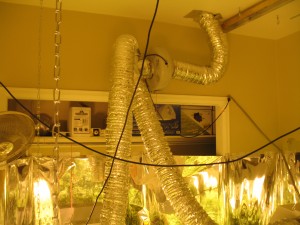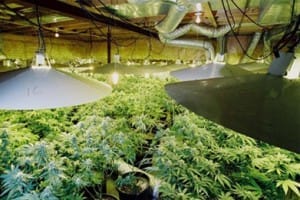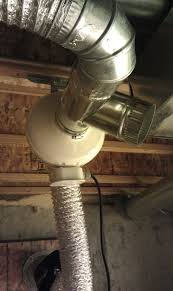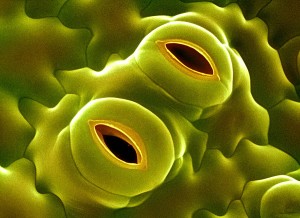 Fresh air is essential in all gardens, though indoors it can be the difference between success and failure. With marijuana growing outdoors, the air is full of carbon dioxide (CO2), which is necessary for plant life.
Fresh air is essential in all gardens, though indoors it can be the difference between success and failure. With marijuana growing outdoors, the air is full of carbon dioxide (CO2), which is necessary for plant life.
When winds blow more carbon dioxide is swept through the garden to replenish the garden. Carbon dioxide (CO2) and oxygen (O) provide the basic building blocks for plant life to grow and flourish.
Carbon dioxide must be present for plants’ photosynthesis process to occur. Oxygen is used by plants for respiration to burn carbohydrates and other foods to create energy.
If soils or soil-less mediums are too packed or soggy with water, no oxygen will reach the roots. Roots also use air, so oxygen must be always present in the nutrient solution for the roots to absorb nutrients for marijuana growing.
Without oxygen and carbon dioxide, plants would not grow and plants that are still growing will quickly die.
Air Movement For Marijuana Growing
Air ventilation and circulation is one of the essential parts of healthy marijuana growing indoors. Many times, people who start marijuana growing indoors overlook air ventilation/circulation and have a small harvest or even none at all.
Fresh air is the least expensive and essential component required for indoor marijuana growing. Three factors affect air movement plants: 1) stomata, 2) ventilation, and 3) circulation.
Cannabis Stomata
Stomata are microscopic pores on leaf undersides, which are similar to an animal’s nostrils, where they breathe in and out oxygen and carbon dioxide. In cannabis, oxygen, and carbon dioxide flows are regulated by the plants’ stomata.
The more plants and larger they are, the fresher CO2-rich air they will need for marijuana growing to be successful. Stomata are easily clogged by dirt from pollutants in the air and by sprays being applied to the leaves. To keep plant foliage clean, spray them down with water.
Air Circulation
Plants use all of the CO2 around the leaf within a few minutes. If there is no CO2 to replace it, CO2-depleted air creates a dead air zone around the leaves. If air is not actively moving, it stifles stomata and the air around leaves stratifies.
With warm air staying up by the ceiling and cool air down by the plant roots, having air circulating will help to break this stratification. This is why having air circulating within the room helps plants.
With proper air circulation in a room, it can help prevent harmful pest and fungus attacks, with the plants constantly being hit by burns of air movement.
Indoor Marijuana Growing Ventilation
 Fresh air is easy to obtain and inexpensive to maintain. With the proper fan size, placement, and hookup you can create the necessary flow of fresh air to the room. Plants transpire (similar to evaporation) most water into the air.
Fresh air is easy to obtain and inexpensive to maintain. With the proper fan size, placement, and hookup you can create the necessary flow of fresh air to the room. Plants transpire (similar to evaporation) most water into the air.
If this is allowed to build up within a room, plants can raise humidity levels to above-recommended levels. This air must be replaced with fresh, dry air.
Ventilation is as important as water, light, heat, and fertilizer to plants so a vent fan that extracts air from the grow room, is the best solution to remove humid, stale air.
All grow rooms no matter their size or shape requires ventilation. A vent fan that pulls air out of a room four times more efficiently than a fan can push it out of a room.
Once the air is evacuated, new air is immediately drawn in through intake vents, if there is no intake vent then it will be pulled from any other cracks and openings in the room. Fans are rated on how many Cubic Feet-Per-Minute (CFM), a fan you purchase should be able to remove all air from your grow room within 5 minutes.
To figure this out, you will need to take the room (length x width x height = total volume in cubic feet).
For Example:
Room: 10’ x 10’ x 10’ = 1000 Cubic Feet.
Fan: Install a 200 CFM for air exchange.
Outcome: It will take exactly 5 minutes to clear the room of old air and replace it with new.
 When you are bringing in new air to your garden, be sure that the air intake has a filter or screen on it to prevent pests from entering your garden.
When you are bringing in new air to your garden, be sure that the air intake has a filter or screen on it to prevent pests from entering your garden.
There are new mushroom-shaped filters that are great, in that fact that they are easily cleaned, easily attached, and keep out bugs, pests, and pollen from passing through the oily filter.
Another option is to use a fine mesh screen or a mosquito net to cover the intake. Circulation fans must be very large to adequately increase the air pressure within a room if you are using them for ventilation.
The most efficient type of fan for air is a venting fan since these exchange air quickly and efficiently. Squirrel cage blowers are commonly used for ventilation and are efficient at moving air, but are loud and need to be mounted on rubber matting to prevent vibration noise as well.
In-line fans are designed to fit in a duct pipe, they are mounted to a wall or hang, increase air flow, are quiet, and are high quality, these work best for venting rooms and lights. Propeller or muffin fans with large fan blades are efficient and quiet to operate when at low RPMs.
These are mounted to the ceiling and provide air movement throughout the room providing good room air circulation. Hot air naturally rises, so if you can take advantage of this natural tendency, you can strategically place vents high enough on the walls or the ceiling; this will create a passive heat removal system that is silent.
General Indoor Ventilation FACTOIDS:
- The larger the diameter or opening of the exhaust duct the more air that can travel through it.
- Vent fans are typically connected to ducting to direct air outside of the grow room.
- Keeping the ducting straight and short will increase the airflow efficiency.
- The more bends and corners, the lower the air flow rate will be.
- Ninety-degree corners or bends in an air duct will cut the airflow by 60% with a single bend.
- Forty-five-degree corners or bends in an air duct will cut the airflow by 40%.
- A thirty-degree corner or bend will in air duct cut the airflow by 20%.
- While a straight duct will make air flow the best.
- You should make as many straight ducts and connections as possible to avoid airflow efficiency loss.
Air Intake For Marijuana Growing
 Many grow rooms that are built have plenty of fresh air coming through cracks and holes, while others are tightly sealed and require fresh air to be brought into the room with fans. An intake fan is the same as an exhaust fan, but blows fresh air into the room instead of out.
Many grow rooms that are built have plenty of fresh air coming through cracks and holes, while others are tightly sealed and require fresh air to be brought into the room with fans. An intake fan is the same as an exhaust fan, but blows fresh air into the room instead of out.
It is always good practice to make your marijuana growing room have negative pressure. Negative pressure is when there is more air being pulled out of the room than is being delivered to the room, causing the door to automatically shut.
Usually, a ratio of 1:4 is used, 100 CFM incoming and 400 CFM outgoing. By having negative pressure air does not have a chance to leak out the intake and release odors outdoors (if running constantly), while also helping CO2 (Carbon Dioxide) enhancement within indoor grow rooms to keep the CO2 in the room.
Larger ducting such as 8, 10, and 12-inch (20, 25, 30 cm) is ideal for moving larger volumes of air when needed, though if your marijuana growing operation is smaller and has fewer heat issues, you can use either 4 or 6 inches ducting.
It is often recommended to pipe air to the plants via flexible ducting. This will allow the fresh air to pour down onto the plants and refresh them with oxygen and carbon dioxide. Be sure that the fresh air is neither too hot nor too cold; many growers will duct air from a crawlspace or under a patio to bring in cool air.
Let us know what you think.






Responses